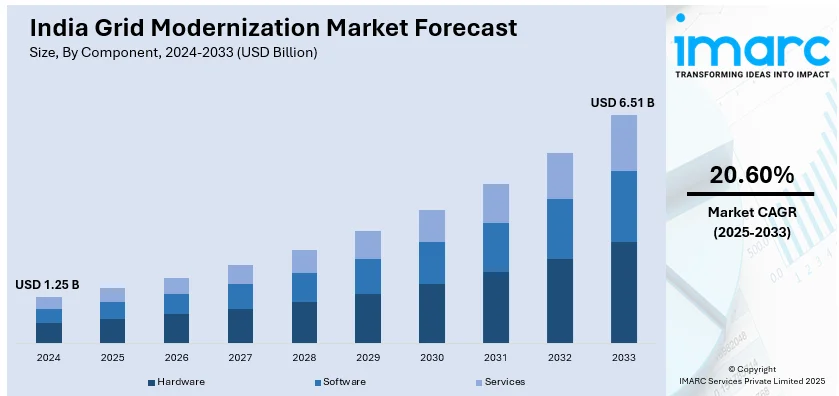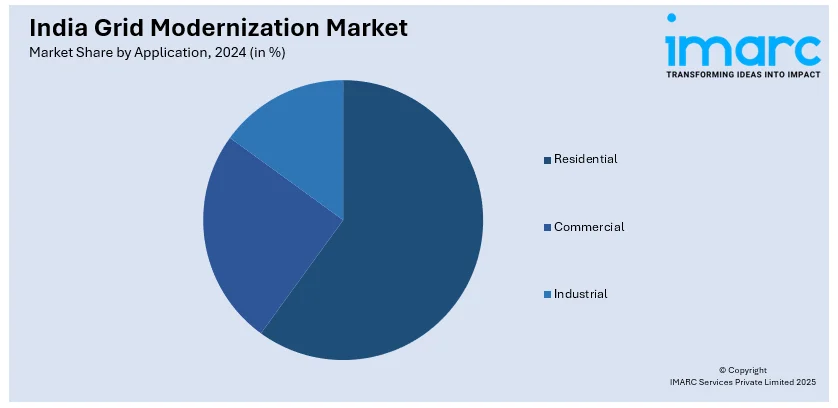
India Grid Modernization Market Size, Share, Trends and Forecast by Component, Application, End-User, and Region, 2025-2033
India Grid Modernization Market Overview:
The India grid modernization market size reached USD 1.25 Billion in 2024. Looking forward, IMARC Group expects the market to reach USD 6.51 Billion by 2033, exhibiting a growth rate (CAGR) of 20.60% during 2025-2033. The market is driven by rising electricity demand, rapid urbanization, and industrialization. Government initiatives such as the Smart Grid Mission and RDSS, along with ambitious renewable energy targets, are also favoring the India grid modernization market growth. The need for efficient power distribution, reduced transmission losses, and integration of renewables further accelerate investments in advanced grid technologies and infrastructure upgrades.
|
Report Attribute
|
Key Statistics
|
|---|---|
|
Base Year
|
2024 |
|
Forecast Years
|
2025-2033
|
|
Historical Years
|
2019-2024
|
| Market Size in 2024 | USD 1.25 Billion |
| Market Forecast in 2033 | USD 6.51 Billion |
| Market Growth Rate (2025-2033) | 20.60% |
India Grid Modernization Market Trends:
Increasing Adoption of Smart Grid Technologies
The significant shift toward the adoption of smart grid technologies is positively influencing the India grid modernization market share. With the growing demand for reliable and efficient power distribution, utilities are investing in advanced metering infrastructure (AMI), distribution automation, and real-time monitoring systems. These technologies enable better demand response, reduce transmission losses, and improve grid stability. The Indian government’s initiatives, such as the Smart Grid Mission and the Revamped Distribution Sector Scheme (RDSS), are further accelerating this trend. Additionally, the integration of renewable energy sources including solar and wind into the grid has necessitated the deployment of smart grids to manage intermittent power supply effectively. On 26th February 2025, Unilever signed a 20-year agreement to obtain solar energy in India that would deliver 45 MW of renewable energy to 32 locations in 15 states, including its manufacturing plants and ten partner manufacturers. This endeavor complements India's endeavors to modernize its grid. It is projected to decrease carbon emissions by 28,000 tonnes of CO₂e per year while cutting down electricity costs by 25%, thus helping India in its clean energy transition. Also, the elimination of the transmission fee for early adopters is among government incentives that advance the initiative toward sustainable energy infrastructure. As urbanization and industrialization continue to rise, the need for resilient and adaptive grid infrastructure is driving the market toward smarter, more connected solutions.

To get more information on this market, Request Sample
Rising Focus on Renewable Energy Integration
Another key trend favorably affecting India grid modernization market outlook is the increasing focus on integrating renewable energy into the power grid. India has set ambitious targets to achieve 500 GW of renewable energy capacity by 2030, which requires substantial upgrades to the existing grid infrastructure. Based on its goal of 500 GW of renewable energy by 2030, India will need to invest USD 300 Billion and needs 20% annual growth in financing. Modernization efforts are centered on enhancing grid flexibility, energy storage solutions, and advanced forecasting tools to accommodate the variable nature of renewables. Technologies such as battery energy storage systems (BESS) and grid-scale inverters are gaining traction to ensure seamless integration. Furthermore, the government’s push for green energy and international collaborations for funding and technology transfer are propelling this trend. As renewable energy penetration grows, grid modernization will play a pivotal role in maintaining energy security and achieving India’s sustainability goals.
India Grid Modernization Market Segmentation:
IMARC Group provides an analysis of the key trends in each segment of the market, along with forecasts at the country level for 2025-2033. Our report has categorized the market based on component, application, and end-user.
Component Insights:
- Hardware
- Software
- Services
The report has provided a detailed breakup and analysis of the market based on the component. This includes hardware, software, and services.
Application Insights:

- Residential
- Commercial
- Industrial
A detailed breakup and analysis of the market based on the application have also been provided in the report. This includes residential, commercial, and industrial.
End-User Insights:
- Utilities
- Independent Power Producers (IPPs)
- Government and Municipalities
The report has provided a detailed breakup and analysis of the market based on the end-user. This includes utilities, independent power producers (IPPs), and government and municipalities.
Regional Insights:
- North India
- South India
- East India
- West India
The report has also provided a comprehensive analysis of all the major regional markets, which include North India, South India, East India, and West India.
Competitive Landscape:
The market research report has also provided a comprehensive analysis of the competitive landscape. Competitive analysis such as market structure, key player positioning, top winning strategies, competitive dashboard, and company evaluation quadrant has been covered in the report. Also, detailed profiles of all major companies have been provided.
India Grid Modernization Market News:
- February 20, 2025: Tata Power partnered with Amazon Web Services (AWS) to bring artificial intelligence, the Internet of Things, and cloud computing technologies to modernize India's energy grid for facilitating more piecemeal and real-time management of this grid. Key apps, 23 of them have migrated, along with AI-powered data lakes that enable predictive maintenance, yielding fewer outages and better supply/demand balancing. The multinational’s digital revolution is instrumental in advancing India’s clean energy transition, setting benchmarks for smart, customer-friendly energy solutions.
- February 28, 2024: GE T&D India received orders worth ₹370 Crore (around USD 3.7 Billion) from the Power Grid Corporation of India (PGCIL) for the supply of 765 kV shunt reactors, bolstering India’s grid modernization initiatives. Scheduled for delivery within FY26, these reactors are intended to enable the integration of renewable energy and enhance transmission capacity. This equipment will be manufactured in India as the Make in India program of the company will give it a leading edge in the high voltage grid solution segment.
India Grid Modernization Market Report Coverage:
| Report Features | Details |
|---|---|
| Base Year of the Analysis | 2024 |
| Historical Period | 2019-2024 |
| Forecast Period | 2025-2033 |
| Units | Billion USD |
| Scope of the Report |
Exploration of Historical Trends and Market Outlook, Industry Catalysts and Challenges, Segment-Wise Historical and Future Market Assessment:
|
| Components Covered | Hardware, Software, Services |
| Applications Covered | Residential, Commercial, Industrial |
| End-Users Covered | Utilities, Independent Power Producers (IPPs), Government and Municipalities |
| Regions Covered | North India, South India, East India, West India |
| Customization Scope | 10% Free Customization |
| Post-Sale Analyst Support | 10-12 Weeks |
| Delivery Format | PDF and Excel through Email (We can also provide the editable version of the report in PPT/Word format on special request) |
Key Questions Answered in This Report:
- How has the India grid modernization market performed so far and how will it perform in the coming years?
- What is the breakup of the India grid modernization market on the basis of component?
- What is the breakup of the India grid modernization market on the basis of application?
- What is the breakup of the India grid modernization market on the basis of end-user?
- What is the breakup of the India grid modernization market on the basis of region?
- What are the various stages in the value chain of the India grid modernization market?
- What are the key driving factors and challenges in the India grid modernization market?
- What is the structure of the India grid modernization market and who are the key players?
- What is the degree of competition in the India grid modernization market?
Key Benefits for Stakeholders:
- IMARC’s industry report offers a comprehensive quantitative analysis of various market segments, historical and current market trends, market forecasts, and dynamics of the India grid modernization market from 2019-2033.
- The research report provides the latest information on the market drivers, challenges, and opportunities in the India grid modernization market.
- Porter's five forces analysis assist stakeholders in assessing the impact of new entrants, competitive rivalry, supplier power, buyer power, and the threat of substitution. It helps stakeholders to analyze the level of competition within the India grid modernization industry and its attractiveness.
- Competitive landscape allows stakeholders to understand their competitive environment and provides an insight into the current positions of key players in the market.
Need more help?
- Speak to our experienced analysts for insights on the current market scenarios.
- Include additional segments and countries to customize the report as per your requirement.
- Gain an unparalleled competitive advantage in your domain by understanding how to utilize the report and positively impacting your operations and revenue.
- For further assistance, please connect with our analysts.
 Request Customization
Request Customization
 Speak to an Analyst
Speak to an Analyst
 Request Brochure
Request Brochure
 Inquire Before Buying
Inquire Before Buying




.webp)




.webp)












